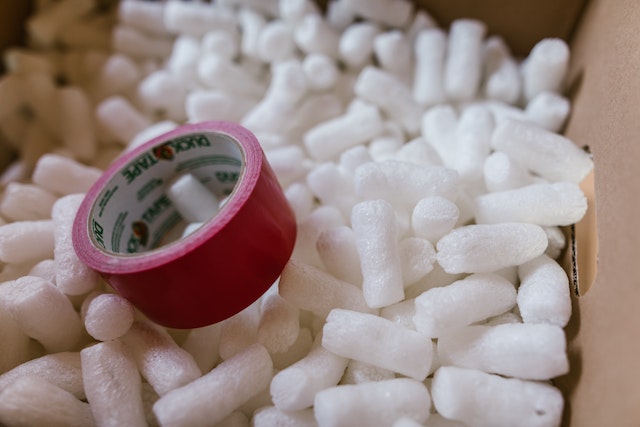Duct tape is a strong adhesive tape that can be used for quick fixes around the house or in emergencies. Gaffer tape is designed for professionals in the entertainment industry who require a strong yet easily removable adhesive.
What is duct tape?
(Photo by RDNE Stock project)

Duct tape is a type of strong adhesive tape that’s also known as “duck tape” due to its water-resistant properties. It was originally used during World War II for sealing ammunition cases, and has since evolved into a versatile tool with many household and industrial uses.
The adhesive layer of duct tape is made from rubber-based materials, which gives it the ability to stick to almost any surface. The outer layer is usually made from a plastic material such as polyethylene or vinyl, making it waterproof and easy to tear by hand.
One downside of using duct tape is that it can leave residue behind when removed, especially if left in place for an extended period. However, this can be easily solved by applying some rubbing alcohol or oil before wiping clean.
Duct tape is great for quick fixes around the house like fixing leaks or securing objects together. Its strength makes it perfect for DIY projects too!
What is gaffer tape?
(Photo By Stewart Black on Flickr)

Gaffer tape, also known as gaff tape, is a type of strong and durable adhesive tape that is typically used in the entertainment industry. Unlike duct tape, which has a rough texture and leaves behind residue when removed, gaffer tape has a smooth surface and can be easily removed without leaving any sticky residue.
Originally designed for use by lighting technicians in theaters and film studios to secure cables to floors or walls without leaving marks or damaging surfaces, gaffer tape quickly became popular among other professionals who needed a reliable adhesive solution that wouldn’t damage equipment or leave marks on sets.
In addition to its original purpose of securing cables and wires on set, gaffer tape is now commonly used for a variety of purposes such as marking stages and floors during performances; temporarily repairing costumes; labeling equipment with identifying information; bundling items together; creating quick fixes for props; adding friction to slippery surfaces; among many others.
One of the key advantages that sets gaffer tape apart from other types of tapes is its ability to conform well to irregular shapes while remaining flexible enough to be torn by hand. This makes it an incredibly versatile tool for artists, builders, designers and DIY enthusiasts alike.
Duct tape Vs. Gaffer tape – Key differences
Duct tape and gaffer tape may look similar, but they have distinct differences that make them unique in their own ways. Firstly, duct tape is made of a plastic-coated fabric with a strong adhesive on one side. It is commonly used for quick fixes around the house, such as sealing leaks or binding objects together.
On the other hand, gaffer tape has a cloth backing coated with natural rubber adhesive. It was originally designed for use in the film industry to secure lighting cables and props on set without leaving residue when removed.
Another difference between these two tapes is their strength. Duct tape tends to be thicker and stronger than gaffer tape because it’s intended for heavy-duty applications like repairing vehicles or holding up insulation.
Gaffer tape typically has less adhesive than duct tape, which allows it to be easily removed from surfaces without damaging them. This makes it ideal for temporary use during events or performances where multiple wires need securing quickly.
In summary, while both duct tape and gaffer tape may look alike at first glance – they are fundamentally different products designed with specific uses in mind. Knowing the differences between them will help you choose which product best suits your needs depending on what you require it for!
How to use duct tape
Duct tape is a versatile adhesive that can be used for various purposes. Here are some tips on how to use duct tape effectively.
Firstly, always ensure the surface you intend to apply the duct tape is clean and dry. Any dirt or grease will weaken the bond between the tape and the surface.
Secondly, when applying duct tape, press it firmly onto the surface using your fingers or a roller tool. This will help eliminate any air pockets beneath the tape which could cause it to lift or lose its grip over time.
Thirdly, if you need to cut duct tape, use a sharp pair of scissors instead of tearing it with your hands. This helps create clean edges and reduces fraying that could lead to weakened adhesion.
Avoid leaving duct tape exposed to direct sunlight or extreme heat as this may cause it to become brittle and lose its stickiness.
By following these tips, you can make sure that your projects stay secure and intact using this trusty adhesive!
How to use gaffer tape
Gaffer tape is a strong adhesive tape that is popularly used in the entertainment industry. However, it has many practical uses outside of this field as well.
When using gaffer tape, make sure that you are applying it to a clean and dry surface. This will ensure maximum adhesion and prevent the tape from peeling off easily.
To tear the tape, use your fingers to fold over one corner of the tape slightly. Then, pull downwards quickly and firmly to tear off a piece of the desired length.
Gaffer tape can be used for various purposes such as holding cables or wires in place, securing equipment or props on set, repairing household items temporarily, labeling objects or even creating makeshift clothing alterations!
One great thing about gaffer tape is its ability to be removed without leaving behind any residue or damaging surfaces. To remove it cleanly, simply peel back slowly while pulling at an angle towards yourself instead of straight up.
When using gaffer tape always ensure a clean and dry surface for maximum adhesion; tear by folding over one corner then pulling down sharply; use for various purposes such as holding cables/wires in place; label objects/parts with ease; create temporary repairs/alterations etc.; remove gently by peeling back slowly while angling towards yourself instead of straight up!
The many uses of duct tape
Duct tape is one of the most versatile tools in a DIY enthusiast’s arsenal. Whether you’re fixing something around the house or crafting a new project, duct tape can come to your rescue in many ways.
One of the most common uses for duct tape is repairing items such as leaky pipes, torn curtains, and broken furniture. Its strong adhesive properties make it perfect for sticking things together quickly and efficiently.
Another great use for duct tape is creating temporary solutions such as makeshift bandages or splints. It can also be used to seal up leaks in car hoses or even repair holes in tents while camping.
In addition to its practical applications, duct tape has also become a popular material for crafting projects like wallets, purses, and even clothing. The range of colors available means that you can create unique designs that are both functional and stylish.
Some people have found even more unusual uses for duct tape: from removing lint from clothes to holding up Christmas lights on your roof! With so many potential applications, it’s easy to see why this simple yet effective tool has become an essential item in any toolbox.
The many uses of gaffer tape
Gaffer tape is a versatile tool that has many practical uses in various industries. It’s ideal for photographers, filmmakers, and music artists who work behind the scenes and need to keep equipment or cables organized.
One of the primary benefits of gaffer tape is its adhesive quality. Unlike duct tape, it doesn’t leave a sticky residue when removed from surfaces. This makes it perfect for securing items without damaging them.
In the entertainment industry, gaffer tape is used extensively to secure lighting fixtures or hide exposed electrical wires during live performances or movie shoots. It can also be used to label equipment with color-coded strips so that each piece can be easily identified.
Additionally, gaffer tape can be used as a temporary fix for broken items such as glasses frames or phone screens until they are professionally fixed. Its strength and flexibility make it suitable for wrapping around smaller objects like pens or drumsticks to provide extra grip.
There are countless uses for gaffer tape beyond just fixing things temporarily. Its versatility makes it an essential item in any toolbox or kit bag – ready to use whenever needed!
Which is stronger duct tape or gaffer tape?
When it comes to strength tests, both tapes have their strengths and weaknesses. Duct tape tends to excel in holding power; it can hold up heavy objects for an extended period without breaking down. However, because of its stiff nature, it may not conform well around corners or irregular surfaces.
Gaffer tape’s strength lies in its flexibility; it can wrap around tricky shapes without losing grip easily. It also leaves no residue behind when removed compared to duct tapes sticky leftovers after removal.
Though if we had to pick one over the other regarding strength alone – Duct Tape would be our winner as being tougher!.
Featured Image By – Lucas Dudek on Unsplash









